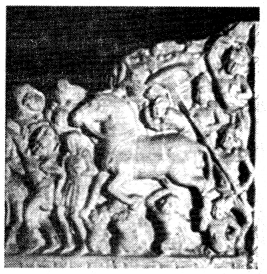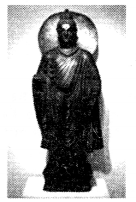Do you need some help in preparing for your upcoming Class 12 History exam? We’ve compiled a list of MCQ questions on Thinkers, Beliefs and Buildings Class 12 MCQs Questions with Answers to get you started with the subject. You can download NCERT MCQ Questions for Class 12 History Chapter 4 Thinkers, Beliefs and Buildings: Cultural Developments with Answers Pdf free download, and learn how smart students prepare well ahead MCQ Questions for Class 12 History with Answers. Start your preparation with MCQ on Thinkers, Beliefs and Buildings Class 12 Objective Questions.
Thinkers, Beliefs and Buildings Class 12 MCQs Questions with Answers
Question 1.
Where did Buddha attain enlightenment?
(a) Lumbini
(b) Sarnath
(c) Gwalior
(d) Bodh Gaya
Answer
Answer: (d) Bodh Gaya
Question 2.
What was the name of the gana to which Buddha belonged to?
(a) Licchavi
(b) Sakya
(c) Koliyas
(d) Kamboj
Answer
Answer: (b) Sakya
Question 3.
What is the meaning of ‘Three baskets’?
(a) Tirthankara
(b) Triratna
(c) Tipitaka
(d) Trishula
Answer
Answer: (c) Tipitaka
Question 4.
The Sangha was an association of whom?
(a) Bhikkus
(b) merchants
(c) traders
(d) dancers
Answer
Answer: (a) Bhikkus
Question 5.
According to which Buddhist text Asoka distributed portions of the Buddha’s relics to every important town and ordered the construction of stupas over them?
(a) Ashokavadana
(b) Mahaparinibbana Sutta
(c) Sutta Pitaka
(d) Vessantara Jataka
Answer
Answer: (a) Ashokavadana
Question 6.
What does the symbol of ‘empty seat’ symbolise?
(a) First Sermon of the Buddha
(b) An event in the life of Buddha
(c) Wisdom of the Buddha
(d) Meditation of the Buddha
Answer
Answer: (d) Meditation of the Buddha
Question 7.
Which of the following is the most important idea in Jainism?
(a) Observing celibacy
(b) Entire world is animated
(c) Belief in non-violence
(d) Asceticism and penance are required to free oneself from the cycle of Karma.
Answer
Answer: (b) Entire world is animated
Question 8.
Who provided money for the preservation of the Sanchi Stupa?
(a) John Marshall
(b) Begums of Bhopal
(c) Alexander Cunningham
(d) None of the above
Answer
Answer: (b) Begums of Bhopal
Question 9.
What was the balcony-like structure in a stupa called?
(a) Anda
(b) Harmika
(c) Yashti
(d) Chhatri
Answer
Answer: (b) Harmika
Question 10.
Which of the following statements is incorrect regarding the lively discussions and debates in the Buddhist texts?
(a) Debates took place in the kutagarashala.
(b) Many of the teachers questioned the authority of the Vedas.
(c) In these debates the kings tried to convince one another as well as laypersons about the validity of their philosophy or the way they understood the world.
(d) If a philosopher succeeded in convincing one of his rivals, the followers of the latter also became his disciples.
Answer
Answer: (c) In these debates the kings tried to convince one another as well as laypersons about the validity of their philosophy or the way they understood the world.
Question 11.
Where is Sanchi Stupa situated?
Answer
Answer: Sanchi Stupa is situated in a village named Sanchi Kanakhera in Bhopal.
Question 12.
________ is the biography of a saint or religious leader.
Answer
Answer: Hagiography
Question 13.
_________ was preceded by 23 other teachers or Tirthankaras.
Answer
Answer: Mahavira
Question 14.
Look at the given picture. What is depicted in the sculpture?

Answer
Answer: It is a sculpture belonging to c. 200 CE from Amravati. It depicts the departure of the Buddha from his palace.
Question 15.
Look at the given picture. Identify and name the school of art to which this sculpture belongs to.

Answer
Answer: This sculpture is of a Bodhisatta from Gandhara School of Art.
Question 16.
What is a sangha?
Answer
Answer: Sangha is an organisation of the monks who too became teachers of Dhamma.
Question 17.
Consider the following statements regarding Sangha.
(i) Mahapajapati Gotami persuaded Buddha to allow women into the sangha.
(ii) Many women who entered the sangha became teachers of Dhamma and went on to become theris.
(iii) Once within the sangha, all were regarded as equal.
Which of the following statements is/are correct?
(a) I and II
(b) II and III
(c) I and III
(d) II only
Answer
Answer: (b) II and III
Question 18.
Match the following.
| (i) Lumbini | (a) Buddha attained Nibbana |
| (ii) Kusinagara | (b) Buddha delivered his first sermon |
| (iii) Sarnath | (c) Buddha was born |
| (iv) Bodh Gaya | (d) Buddha attained enlightenment |
Choose the correct option
(a) i – b, ii – c, iii – a, iv – d
(b) i – c, ii – a, iii – b, iv – d
(c) i – c, ii – b, iii – a, iv – d
(d) i – d, ii – a, iii – b, iv – c
Answer
Answer: (b) i – c, ii – a, iii – b, iv – d
Question 19.
Consider the following statements regarding the structure of the stupa.
(i) Harmika is a balcony-like structure that represented the abode of gods.
(ii) A mast called the anda arose from the harmika.
(iii) A yashti was often surmounted by a chhatri or umbrella.
(iv) Yashti arose from the harmika.
Which of the following statements is/are correct?
(a) I, II and III
(b) II, III and IV
(c) I and IV
(d) I, III and IV
Answer
Answer: (d) I, III and IV
Question 20.
Given below are two statements, one labelled as Assertion (A) and the other labelled as Reason (R):
Assertion (A): The mid-first millennium BCE saw the emergence of new religions in India.
Reason (R): People began speculating on the significance of the sacrificial tradition and authority of the Vedas.
(a) Both (A) and (R) are correct and (R) is the correct explanation of (A).
(b) Both (A) and (R) are correct and (R) is not the correct explanation of (A).
(c) (A) is correct but (R) is not correct.
(d) (R) is correct but (A) is not correct.
Answer
Answer: Both (A) and (R) are correct and (R) is the correct explanation of (A).
Question 21.
Read the information given below:
Identify and name the Buddhist text.
| This unique Buddhist text, part of the Sutta Pitaka, is a collection of verses composed by bhikkhunis. It provides an insight into women’s social and spiritual experiences. |
Answer
Answer: The Therigatha
Question 22.
Match the following.
| (i) Metta | (a) soulless |
| (ii) Karuna | (b) fellow feeling |
| (iii) Anatta | (c) sorrow |
| (iv) Dukkha | (d) compassion |
Choose the correct option
(a) i – b, ii – d, iii – a, iv – c
(b) i – c, ii – a, iii – b, iv – d
(c) i – c, ii – b, iii – a, iv – d
(d) i – d, ii – a, iii – b, iv – c
Answer
Answer: (a) i – b, ii – d, iii – a, iv – c
We hope you found this CBSE Class 12 History Thinkers, Beliefs and Buildings MCQs Multiple Choice Questions with Answers helpful. If you have any questions about NCERT MCQ Questions for Class 12 History Chapter 4 Thinkers, Beliefs and Buildings: Cultural Developments with Answers Pdf free download, please share them in the comment box below and we will get back to you at the earliest possible time.